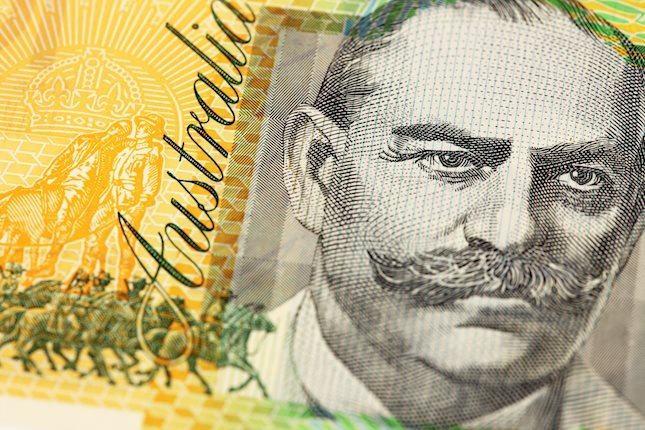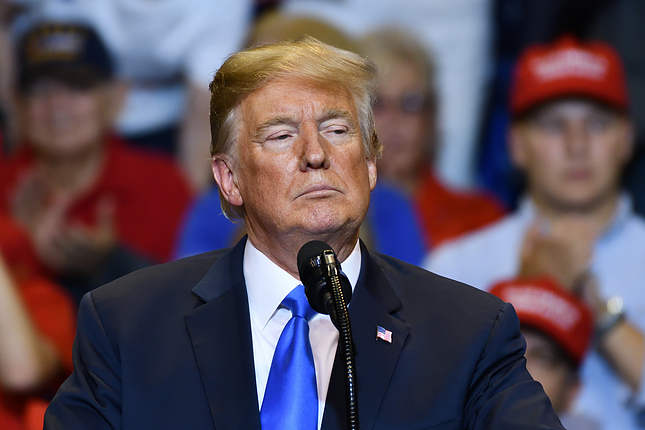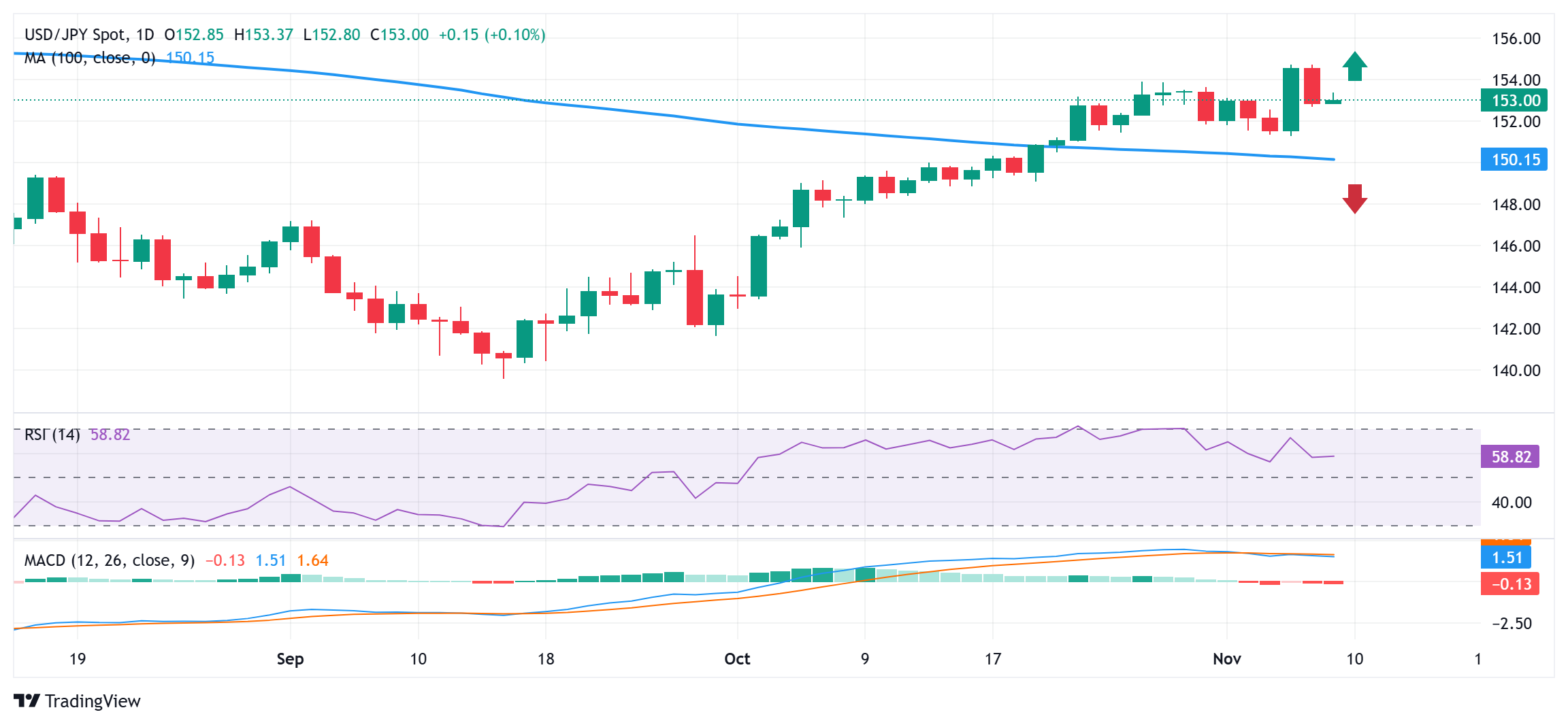- The Japanese Yen gains some follow-through traction amid government intervention fears.
- The BoJ rate-hike uncertainty and the risk-on mood might cap gains for the safe-haven JPY.
- The emergence of some USD dip-buying could further offer support to the USD/JPY pair.
The Japanese Yen (JPY) attracts some dip-buying during the Asian session and looks to build on the overnight recovery against its American counterpart, from the lowest level since July 30. Some verbal intervention from Japanese authorities turns out to be a key factor lending support to the JPY. This, along with a softer tone surrounding the US Treasury bond yields, acts as a tailwind for the lower-yielding JPY.
Meanwhile, a decline in Japan's real wage and household spending for the second straight month in September dampens the inflation outlook and could delay the Bank of Japan's (BoJ) rate-hike plans. This, along with Japan's political landscape and the risk-on mood, should cap the safe-haven JPY. Apart from this, the emergence of some buying around the US Dollar (USD) might limit the downside for the USD/JPY pair.
Japanese Yen remains on the front foot amid fears about possible government intervention
- Government data released this Friday showed that Japan's household spending fell for the second successive month, by 1.3% in September and 1.1% from the year earlier.
- This comes on top of a fall in Japan's inflation-adjusted wages for the second straight month in September and could hinder the Bank of Japan's plans to hike rates further.
- Donald Trump’s victory in the US presidential election pushed the USD/JPY pair beyond the 154.00 mark on Wednesday and prompted verbal intervention by authorities.
- Japan's Chief Cabinet Secretary, Yoshimasa Hayashi, reiterated that the government intended to closely watch moves in the FX market with a higher sense of urgency.
- Japan’s Vice Finance Minister for International Affairs and top FX official Atsushi Mimura said that the government is ready to take appropriate actions against excessive FX moves.
- Japan’s Finance Minister Katsunobu Kato on Friday that the government will closely monitor the impact of the President-elect Donald Trump's policies on the domestic economy.
- Quarterly data from the Ministry of Finance (MOF) showed this Friday that Japan spent ¥5.53 trillion on currency intervention made during the period from June 27 through July 29.
- The US Dollar attracts some dip-buying on Friday to reverse a part of Thursday's pullback from a four-month top and offer some support to the USD/JPY pair.
- The Federal Reserve lowered borrowing costs by 25 basis points on Thursday, following a jumbo rate cut in September that kicked off the policy easing cycle.
- In the post-meeting press conference, Fed Chair Jerome Powell failed to offer any cues that the central bank was likely to pause rate cuts in the near term.
- According to the CME Group's FedWatch Tool, market participants are now pricing in 75% odds the US central bank will cut interest rates again in December.
- Furthermore, traders continue to unwind some of the profitable Trump trades, which might cap any meaningful upside for the USD and the currency pair.
Technical Outlook: USD/JPY retreats further from multi-month top, 152.00 holds the key for bulls
From a technical perspective, the overnight downfall stalled near the 152.70-152.65 horizontal support. The said area might now act as a pivotal point, below which the USD/JPY pair could accelerate the corrective decline towards the 152.00 mark en route to the 100-day Simple Moving Average (SMA), around the 151.70-151.65 region. Some follow-through selling will suggest that the recent strong move up from the September monthly swing low has run out of steam and paves the way for deeper losses.
On the flip side, the 153.50 area could act as an immediate hurdle ahead of the 153.85-153.90 supply zone. A subsequent move back above the 154.00 mark has the potential to lift the USD/JPY pair back towards the multi-month peak, around the 154.70 region touched on Thursday. The momentum could extend further toward the 155.00 psychological mark and the 155.20 zone (July 30 swing high).
Fed FAQs
Monetary policy in the US is shaped by the Federal Reserve (Fed). The Fed has two mandates: to achieve price stability and foster full employment. Its primary tool to achieve these goals is by adjusting interest rates. When prices are rising too quickly and inflation is above the Fed’s 2% target, it raises interest rates, increasing borrowing costs throughout the economy. This results in a stronger US Dollar (USD) as it makes the US a more attractive place for international investors to park their money. When inflation falls below 2% or the Unemployment Rate is too high, the Fed may lower interest rates to encourage borrowing, which weighs on the Greenback.
The Federal Reserve (Fed) holds eight policy meetings a year, where the Federal Open Market Committee (FOMC) assesses economic conditions and makes monetary policy decisions. The FOMC is attended by twelve Fed officials – the seven members of the Board of Governors, the president of the Federal Reserve Bank of New York, and four of the remaining eleven regional Reserve Bank presidents, who serve one-year terms on a rotating basis.
In extreme situations, the Federal Reserve may resort to a policy named Quantitative Easing (QE). QE is the process by which the Fed substantially increases the flow of credit in a stuck financial system. It is a non-standard policy measure used during crises or when inflation is extremely low. It was the Fed’s weapon of choice during the Great Financial Crisis in 2008. It involves the Fed printing more Dollars and using them to buy high grade bonds from financial institutions. QE usually weakens the US Dollar.
Quantitative tightening (QT) is the reverse process of QE, whereby the Federal Reserve stops buying bonds from financial institutions and does not reinvest the principal from the bonds it holds maturing, to purchase new bonds. It is usually positive for the value of the US Dollar.
Information on these pages contains forward-looking statements that involve risks and uncertainties. Markets and instruments profiled on this page are for informational purposes only and should not in any way come across as a recommendation to buy or sell in these assets. You should do your own thorough research before making any investment decisions. FXStreet does not in any way guarantee that this information is free from mistakes, errors, or material misstatements. It also does not guarantee that this information is of a timely nature. Investing in Open Markets involves a great deal of risk, including the loss of all or a portion of your investment, as well as emotional distress. All risks, losses and costs associated with investing, including total loss of principal, are your responsibility. The views and opinions expressed in this article are those of the authors and do not necessarily reflect the official policy or position of FXStreet nor its advertisers. The author will not be held responsible for information that is found at the end of links posted on this page.
If not otherwise explicitly mentioned in the body of the article, at the time of writing, the author has no position in any stock mentioned in this article and no business relationship with any company mentioned. The author has not received compensation for writing this article, other than from FXStreet.
FXStreet and the author do not provide personalized recommendations. The author makes no representations as to the accuracy, completeness, or suitability of this information. FXStreet and the author will not be liable for any errors, omissions or any losses, injuries or damages arising from this information and its display or use. Errors and omissions excepted.
The author and FXStreet are not registered investment advisors and nothing in this article is intended to be investment advice.
Recommended content
Editors’ Picks

AUD/USD extends the retreat to near 0.6650 as US Dollar finds footing
AUD/USD is back in the red, testing 0.6650 in Friday's Asian trading. A renewed US Dollar uptick undermines the pair, even as risk sentiment remains in a sweeter spot. However, the downside appears limited amid the RBA's hawkish stance and hopes for more Chinese stimulus could act as a tailwind for the Aussie.

USD/JPY drops back below 153.00 after Japan's verbal intervention
USD/JPY drops back below 153.00 early Friday, snapping the rebound. Japanese verbal intervention outweighs the upbeat market mood and the post-Fed US Dollar rebound, exerting a fresh bearish pressure on the pair. US sentiment data is next in focus.

Gold price slides back below $2,700 mark amid modest USD strength
Gold price met with a fresh supply and eroded a part of the overnight recovery gains. The Trump trade optimism revives the USD demand and weighs on the precious metal. Retreating US bond yields and bets for additional Fed rate cuts could help limit losses.

BTC touches new all-time high near $77,000 following Fed rate cut
Bitcoin price rallied and reached a new all-time high of $76,849 following the US Federal Reserve’s 25 basis point rate cut. Ethereum and Ripple followed suit and closed above their key resistance levels, hinting at a possible rally ahead.

Outlook for the markets under Trump 2.0
On November 5, the United States held presidential elections. Republican and former president Donald Trump won the elections surprisingly clearly. The Electoral College, which in fact elects the president, will meet on December 17, while the inauguration is scheduled for January 20, 2025.

Best Forex Brokers with Low Spreads
VERIFIED Low spreads are crucial for reducing trading costs. Explore top Forex brokers offering competitive spreads and high leverage. Compare options for EUR/USD, GBP/USD, USD/JPY, and Gold.
